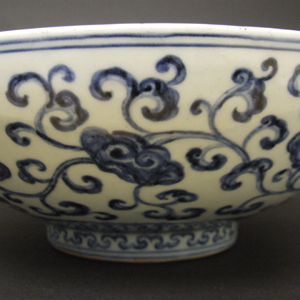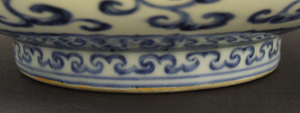
XUANDE MARK AND OF THE PERIOD 1426 – 1435 Imperial Ming Porcelain
A Fine and Rare Imperial Ming Porcelain Bowl, Xuande Six Character Mark and of the Period 1426 – 1435. The Substantially Potted Fruit Bowl is of Shallow Form with Rounded Sides. Decorated in a Strong Cobalt Blue with Lingzhi Fungus Bourne on Continuous Scrolling Vine. The Lower Part of the Bowl with Lappet Bands with Scroll Motifs to the Sides of the Shallow Foot. Below the Double Lines at the Top of the Scrolling Vine is a Xuande Six Character Mark.
SOLD
- Condition
- There are two large cracks to the body which have previously been 'riveted', probably in China. It the cracks meet lower down the bowl. This section has been restuck.
- Size
- N/A
- Provenance
- Sotheby`s 6th July 1976 Lot 214 From the E.Allen Collection. A Private Collection of Chinese Porcelain From 1976.
- Stock number
- 22218
- References
- An imperial Xuande bowl of this pattern is in the Beijing Palace Museum and is illustrated in : Blue and White Porcelain with Underglaze Red(I), the Complete Collection of Treasures of the Palace Museum, Hong Kong, 2000. Page 156. Another Xuande bowl of this pattern is in the National Palace Museum, Taipei, this is illustrated in : Catalogue of the Special Exhibition of Selected Hsuan-te Imperial Porcelains of the Ming Dynasty. Page 144. For a further Xuande bowl of this design see : Important Chinese Ceramics and Works of Art, Christie`s Hong Kong, 27th November 2007 sold for HK$ 6,935.500. Exhibited / Published : `Mittens Rike`. Items on loan from collectors in the Ming Tz’u society in Boras, Sweden, October 1985. Museum of Far Eastern Antiques, Stockholm. Röhska Museum, Gothenburg. Kempe Collection, Ekolsund. Historical Museum, Gothenburg and Kulturen, Lund. `Mittens Rike` Cultural centre of Boras Sweden. `Mittens Rike` had 835 exhibits and a printed 200 page catalogue. The bowl was discussed by Ms. Margaret Medley (PDF), Prof. Bo Gyllensvärd (MFEA), Dr Jan Wirgin (MFEA) among others. The label from this exhibition is on the base of the bowl. Catalogue Entry :(Translation from Swedish to English) No. 202 Hsuan-Te Dice Bowl Bowl in porcelain decorated in underglazed blue picturing flowers, vines and ling-chih fungus. D. 29 cm. Xuande’s six-characters and of the period. The bowl is called “dicebowl”, used at games, hence the strong construction.
Information
Xuande 1426 - 1435
Hongxi was Yongle`s eldest son, he was ill and only reigned China for less than a year during 1425. He had 10 sons of which Xuande was the eldest. Born in 1398 as Zhu Zhanji he became Hair Apparent in 1424 and on accession to the imperial throne in 1426 he took the name Xuande. He is seen as one of the great emperors of China, indeed Ann Paludan in her book `Chronicle of the Chinese Emperors` refers to him having "something of the Renaissance `perfect man` about him". Xuande skills were wide ranging, he had the ability to reform and reorganise the country, as well as great military skills but he was also a poet and artist as well. Xuande particularly liked painting animals and some of these are still in existence in the National Palace Museum, Taipei (see `Links`). He would often sign his works as `Playfully painted by the imperial brush`. He was a great patron of the arts and an avid collector who sent eunuchs to collect valuable rarities from all over China. Xuande died in 1435 and was buried with 10 concubines at the Xuanzong tomb (`Proclaimed Ancestor`), Jingling, Shisanling, Hebei.



